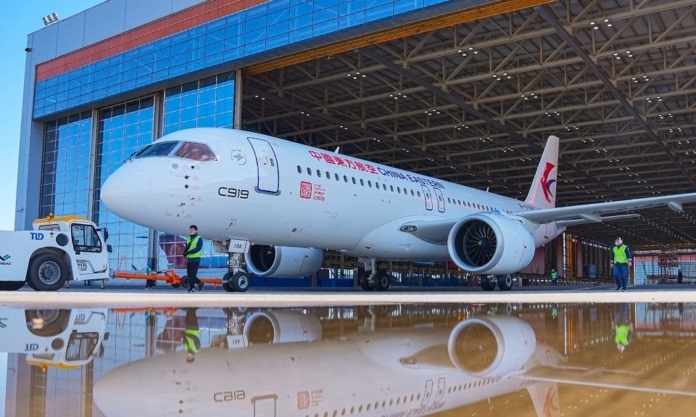Today is a big day for China in terms of aviation. For finally the time has come to deliver the nation’s first domestically-produced passenger airliner to its launch customer. But is this indicative of the sun setting on the near monopoly enjoyed by Boeing and Airbus?
The first C919 was this morning delivered to China Eastern Airlines. But the project, beset by delays, has been fully 14 years in the making.
Founded in 2008 and headquartered in Shanghai, the Commercial Aircraft Corporation of China (COMAC) has more than 8,300 employees, who have been working ever since to vitalise China’s airline production capability and pose a threat to the dominance of its American and European rivals.
But the main problem for COMAC is the challenge to get airlines to move away from the tried and trusted. COMAC claims it has received 815 orders from 28 customers, but as industry-insider portal, ch-aviation.com, reported in October, its firm order book comprises only 188 units.
China Eastern itself is only going to take five C919s, having signed a contract for the purchase of such on 1 March, 2021. Of the 37 aircraft that China Eastern Airlines plans to introduce in 2023, just four shall be C919-series aircraft.
Of those, only one, this launch aircraft, will fly China Eastern colours; the remainder are to be operated by China Eastern subsidiary, OTT Airlines, formerly Easternjet until 2020.
The C919 isn’t even entirely Chinese.
The aircraft is in fact powered by CFM International LEAP-1C engines. Those are produced by a 50/50 joint venture between General Electric and Safran Aircraft Engines.
It is thought to still be quite some time before China can domestically produce engines of sufficient quality to satisfy air worthiness, reliability and safety concerns.
The LEAP-1C was simultaneously awarded Type Certificates by both the European Aviation Safety Agency (EASA) and the U.S. Federal Aviation Administration (FAA) on 21 December, 2016.
The choice of “C” as prefix for the aircraft type is thought by some to be indicative of the Comac, and indeed China’s, ambitions. In the minds of the dreamers, in an “ABC” scenario, “A” stands for Airbus, “B” for Being and “C” for COMAC.
Interestingly, the LEAP 1A engine can be found powering Airbus 320neo aircraft, while the LEAP 1B sits under the wings of some Boeing 737 MAX planes.
The C919 may be intended to take on competition from the Boeing 737 and the Airbus 320, but more challengers await in the wings.
Brazil’s Embraer has long been known for its smaller, regional jets, but the airline producer has more recently added a larger family of aircraft, with credentials approaching those of the C919.
Embraer’s E195-E2, for example, can offer 146 seats in a single-class configuration. The C919, on the other hand, will typically carry 158-168 passengers.
Another comparison lies in the range. The C919 can fly for 2,500 nautical miles, while the Airbus 320neo manages 3,500. To put that in perspective, an Airbus 320neo could manage (just) the hop from Nanjing to Moscow, while the C919 could make it only as far as Delhi (with a bit of fuel to spare). As a result, the C919 is going to be largely left flying inter-Asia flights.
Then let’s not forget the price tag, where China is once again as opaque as possible. COMAC itself does not publish a price for the C919, but industry experts put it at between US$90 million and US$100 million per unit. While this is certainly quite a bit cheaper than its rivals (the A320neo is listed at US$111 million and the 737 MAX 8 at US$121 million), it’s almost double the US$50 million which was once supposedly a Unique Selling Point for the C919.
With all else mostly fair and square, the big question remains will a saving of US$10-20 million per plane be sufficient to pull airlines away from Airbus and Boeing in the direction of China? So far, it appears not.









